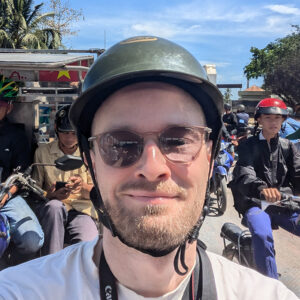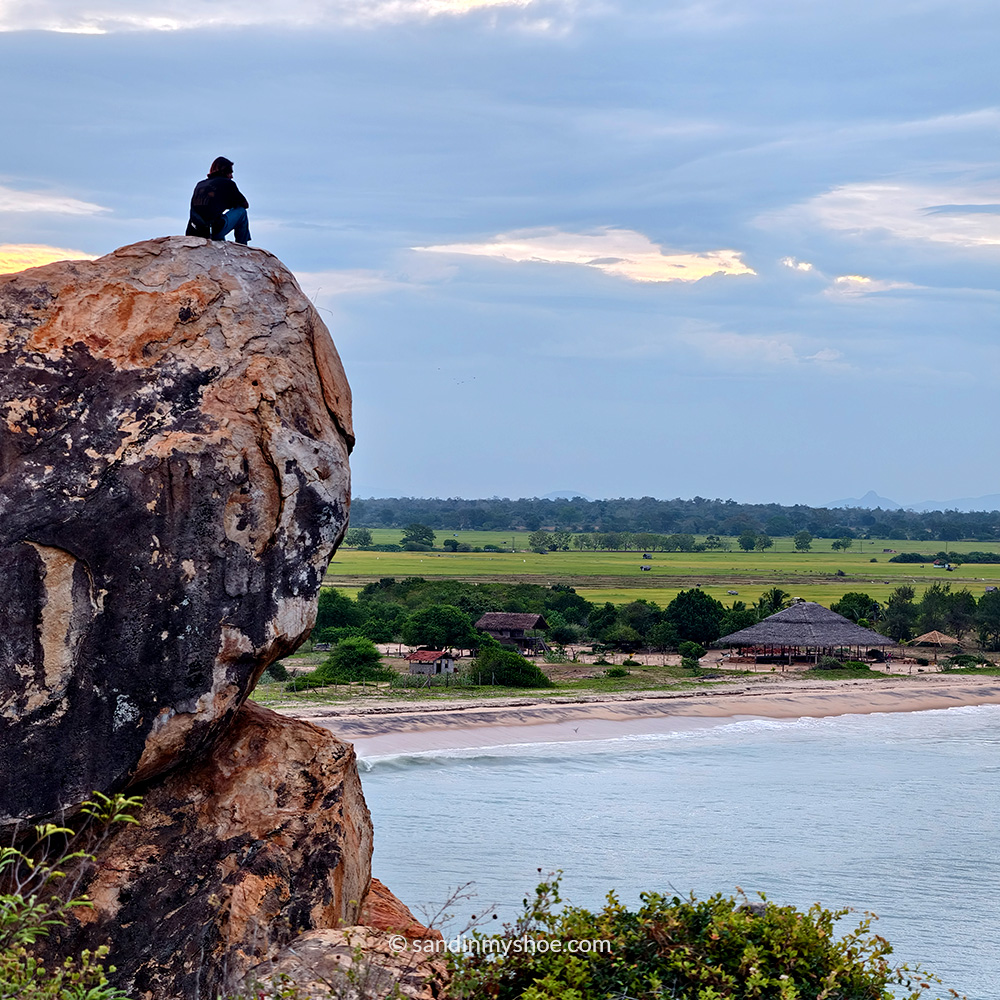In this post, I’ll answer the common question, “Sri Lanka: how many days should you stay?” based on my experience, along with tips on when to visit, where to stay your first night, and several itinerary options to help you make the most of your trip.
How Many Days to Spend in Sri Lanka?
I prefer staying more time in a country when I travel—it allows me to go beyond the surface and experience it a bit deeper. Since Sri Lanka is a relatively small country, I would say, two weeks is enough to experience the highlights and enjoy some downtime on the beaches.
However, if you can stretch your trip to three weeks, you’ll be able to explore the country more thoroughly, without feeling rushed. I stayed 3-weeks and felt that it was the perfect amount of time. Of course, not everyone has the luxury of extended travel, so I’ve created itineraries for 1-week, 2-week, and 3-week journeys to help you make the most of your time—no matter how long you stay.
When to Visit Sri lanka?
The first thing you need to understand about Sri Lanka—before diving into the itineraries—is how its seasonal monsoons affect beach time and outdoor activities like safaris and visiting cultural sights. The island experiences two distinct monsoon systems that impact different regions at different times of the year.
- The South and West Coasts are affected by the southwest monsoon from May to July.
- The North and East Coasts experience the northeast monsoon from October to January, along with unpredictable weather between February and April.
Here’s a quick overview to help you identify which regions to avoid—and which to prioritize—during your trip.
| Period | Best Travel Regions | Beach | National Parks | Cultural Triangle |
|---|---|---|---|---|
| Jan–Apr | West, South and Central regions | West & South Coasts | Yala (leopards; elephants year-round); Wilpattu (leopards); Bundala (birds, whales); Kalpitiya (dolphins) | Feb–Apr the driest period; inter-monsoon squalls in Jan & Apr |
| May–Sep | North, East and Central regions | East Coast, South Coast (secondary surf Jul–Sep) | Wilpattu (dry; palu fruit May–Jul); Minneriya (elephants gathering Jul–Sep); Kaudulla (elephants gathering Jul–Sep); Yala (dry lakes; elephants year-round) | Dry season (Perfect time for culture and sunshine) |
| Oct–Dec | West & South Coasts | West Coast, South Coast | Yala (leopards; elephants year-round); Bundala (birds); Kalpitiya (dolphins) | North East monsoon (Oct–Jan) – rainy, best avoided |
Notes
- Yala’s permanent waterholes guarantee elephant sightings any month.
- Minneriya and Kaudulla host their mass elephant “gathering” only in the dry Jul–Sep window.
- Cultural Triangle refers mainly to Anuradhapura, Polonnaruwa, Sigirya, Dambulla and Kandy
Best time to visit Sri Lanka
As you can see from the table, the driest period across Sri Lanka is from January to April, making it the best time to travel without being caught off guard by monsoons. During these months, most regions—including the south, west, central highlands, and Cultural Triangle—enjoy sunny skies and minimal rainfall.
The second-best travel window is from May to September, but it’s important to base yourself on the east coast if you’re planning beach time. While the southwest coast is affected by monsoon rains during this period, the east remains dry and ideal for swimming, snorkeling, and surfing.
Personally, I traveled to Sri Lanka in May and avoided the south coast due to poor weather conditions due to the monsoon. Surprisingly, Negombo was mostly sunny with just occasional showers, in contrast to central highlands, which were consistently wet, with rain falling almost everyday.
Itineraries for Sri Lanka
Now that you’ve mastered Sri Lanka’s monsoon patterns like a meteorologist, it’s time to dive into the itineraries.
I recommend having a vehicle for many of the routes, as it allows for faster travel and greater flexibility. However, one exception is the scenic train ride between Nuwara Eliya (Nanu Oya Station) and Ella—a favorite among travelers. Having a vehicle can complicate this leg of the journey, but don’t worry: many rental agencies are aware of this and can often arrange for someone to drive your vehicle to the end station.
1-week itineraries
With just 7 days on your disposal, start your trip in the laidback town of Negombo and get yourself transportation: a car, a tuk-tuk or a motorbike and you’ll be able to travel faster and more flexible.
Best Season: January–April
Day 1: Arrive→ Negombo beach relaxation
Day 2: Drive to Wilpattu National Park; evening safari in Wilpattu
Day 3: Morning safari → transfer to Anuradhapura; afternoon temple and stupa tour
Day 4: Sunrise climb at Mihintale → deeper Anuradhapura exploration → drive to Sigiriya
Day 5: Climb Sigiriya Rock Fortress; visit Dambulla Cave Temple; overnight in Sigiriya area
Day 6: Drive back to Negombo; afternoon day-trip to Colombo Fort and Pettah bazaar
Day 7: Morning beach dip in Negombo → transfer to airport → depart
Best Season: Oct–April
Day 1: Arrive and leave for Galle Fort and stay in the area for the night
Days 2–3 (2 nights): Beach base at Unawatuna or Mirissa; swim, sunbathe
Day 4: Whale-watch (Nov–Apr) or coral snorkeling
Day 5: Drive to Yala; evening safari in Yala National Park
Day 6: Morning safari → transfer to Ella; sunset at Little Adam’s Peak
Day 7: Scenic train back to Colombo → depart
Best Season: May–September
Day 1: Land and leave→ Pasikudah beach base (5 h drive from the airport)
Day 2: Morning snorkel at Pigeon Island; afternoon paddleboard the Pasikudah lagoon & feast on fresh seafood
Day 3: Enjoy the beach until afternoon and transfer to Yala region (5 h)
Day 4: Full-day safari in Yala National Park; overnight in a jungle lodge near the park gates
Day 5: Drive to Nuwara Eliya (4 h via scenic hill roads) and visit a tea plantation
Day 6: Nuwara Eliya (Nanu Oya)→Ella scenic train; lunch in Ella town; hike Little Adam’s Peak & wander the Nine Arches Bridge at sunset
Day 7: Leisurely breakfast over tea in Ella; transfer back to Colombo; airport transfer → depart
2-week itineraries
With two weeks at your disposal, you’ll have enough time to use public transport—like buses and trains—for getting around. However, having your own vehicle will make travel faster and far more flexible.
Best Season: May–September
Day 1: Arrive Colombo → Transfer to Sigiriya (evening at your guesthouse)
Days 2–3 (2 nights): Explore Sigiriya Rock Fortress and Dambulla Cave Temples
Day 4: Drive to Trincomalee → relax at Nilaveli Beach
Days 5–6 (2 nights): Snorkel at Pigeon Island, visit Koneswaram Temple and Fort Frederick
Day 7: Transfer to Pasikudah → swim in calm, shallow waters
Days 8–9 (2 nights): Beach time, paddleboarding, and sunset walks
Day 10: Drive to Arugam Bay → chill at beach cafés
Days 11–12 (2 nights): Surf or visit Kumana National Park for a half-day safari
Day 13: Transfer inland to Ella → hike Little Adam’s Peak or visit Nine Arches Bridge
Day 14: Scenic train to Colombo → depart
Best Season: January–April
Day 1: Arrive Colombo → Transfer to Galle; explore Galle Fort
Days 2–3 (2 nights): Beach base at Unawatuna or Mirissa; swim, sunbathe, relax
Day 4: Whale watching (Nov–Apr) or coral snorkeling in Mirissa
Day 5: Drive to Yala → evening safari in Yala National Park
Day 6: Morning safari → transfer to Ella; sunset at Little Adam’s Peak
Days 7–8 (2 nights): Explore Ella Rock, Nine Arches Bridge, and Ravana Falls
Day 9: Scenic train to Nuwara Eliya → visit tea plantation and colonial town
Day 10: Drive to Kandy → visit Temple of the Tooth and walk around the lake
Days 11–12 (2 nights): Transfer to Sigiriya → climb Lion Rock and visit Dambulla Cave Temples
Day 13: Return to Negombo or Colombo → final shopping or beach walk
Day 14: Depart Sri Lanka
3-week itineraries
With three weeks in Sri Lanka, you can slow down, explore more remote corners, and combine cultural landmarks, scenic train rides, and many beachtowns without rushing it.
Best Season: January–April
Day 1: Arrive Negombo and stay the night
Days 2–3 (2 nights): Move to Unawatuna or Mirissa; swim, sunbathe, unwind
Day 4: Whale watching (Nov–Apr) or coral snorkeling in Mirissa
Day 5: Transfer to Tangalle → secluded beach time or turtle watching
Days 6–7 (2 nights): Get to Yala → evening and morning safaris
Day 8: Transfer to Ella → sunset at Little Adam’s Peak
Days 9–10 (2 nights): Hike Ella Rock, visit Nine Arches Bridge, Ravana Falls
Day 11: Scenic train to Nuwara Eliya → tea plantations and colonial town
Days 12–13 (2 nights): Transfer to Kandy → Temple of the Tooth, botanical gardens
Day 14: Day trip to Knuckles Range or chill in Kandy
Days 15–16 (2 nights): Transfer to Sigiriya for hikes and visit Dambulla Cave Temples
Day 17: Safari in Minneriya or Kaudulla (elephants)
Day 18-19: Transfer to Anuradhapura and explore the stupas.
Day 20: Transfer to Negombo for a final beach day or do shopping in Colombo
Day 21: Depart Sri Lanka
Best Season: May–September
Day 1: Arrive in Negombo and stay the night
Day 2-3: Transfer to Anuradhapura and vist the stupas
Day 4: Morning leopard safari in Wilpatty National Park and transfer to Sigirya
Days 5–6 (2 nights): Explore Sigiriya Rock Fortress and Dambulla Cave Temples
Day 7: Safari in Hurulu Eco Park or Minneriya (elephants)
Days 8–9 (2 nights): Transfer to Trincomalee → beach time at Nilaveli or Uppuveli
Days 10-11 (2 nights): Snorkel at Pigeon Island, visit Koneswaram Temple and Fort Frederick
Day 12: Drive to Arugam Bay → sunset at the beach
Days 13–14 (2 nights): Surf or visit Kumana National Park for a half-day safari
Day 15: Chill at beach cafés or hike Elephant Rock
Day 16: Transfer inland to Ella → sunset at Little Adam’s Peak
Days 17–18 (2 nights): Explore Ella Rock, Nine Arches Bridge, and Ravana Falls
Day 19: Scenic train to Nuwara Eliya → visit tea plantations and colonial town
Day 20: Back to Colombo or Negombo → final shopping or beach walk
Day 21: Depart Sri Lanka
Getting around Sri Lanka and its Costs
Getting around Sri Lanka is part of the adventure. If you are short in time, get yourself a transport on your own, but if you are travelling for two weeks or more, embrace the local rhythm—jump on buses, ride the trains, and let the journey itself become part of the experience. I’ll cover some overview prices to give an idea of what to expect.
Local Transport
- Buses: Local buses in Sri Lanka are ridiculously cheap—less than $1 for 100 km—but they’re hot, crowded, and not exactly comfortable. Spend $2–3 instead, and you’ll get an air‑conditioned bus with soft seats and a much more relaxed journey.
- Train: You can travel 100 km in Sri Lanka by train for as little as under $1 in third class, around $1–2 in second class, or $5–10 in first class with air‑conditioning and reserved seats. Nuwara Eliya (Nanu Oya Station) to Ella cost only $0,5 for a third class ticket.
Renting a Tuk-Tuk, Car, or Motorbike
For more flexibility, consider renting your own vehicle. Keep in mind that you need a temporary Sri Lankan driving permit even though you have a International Driving Permit. Fastest way to get it as at Bandaranaike International Airport upon arrival or through your rental company.
- Car or motorbike: Great for longer distances or if you prefer more comfort and speed. You’re not tied to bus schedules and can change plans on the fly. Car: $30–60 per day (add $15–30 extra for a driver). Scooter: $5–10 per day.
- Tuk-tuk: My personal favorite. I explored the country in my own tuk-tuk and loved the freedom it gave me. If I return, I’d rent one again—it’s immersive, refreshing, and surprisingly practical. I paid $10 per day and rented for 17 days. Expect to pay between $10-20 per day.
Curious about tuk-tuk travel? Check out my post: Sri Lanka Tuk Tuk Guide—it covers what it’s like to drive one, how to rent, and what it costs.
Where to Stay the First Night?
One of the first things to consider when planning your trip to Sri Lanka is where to stay on your first night. Regardless of the season, you’ll land at Bandaranaike International Airport, located about 35 km from Colombo, the bustling capital, and just 7 km from Negombo, a laid-back seaside town.
Many travelers arrive tired and prefer calm, relaxed surroundings to recover before starting their journey—Negombo is ideal for that. Others rent a car from the airport and go the south or east directly, while the rest dive straight into the mayhem of Colombo’s energy and urban chaos.
Need help choosing? Check out my post: Colombo vs Negombo to find out which starting point suit you the best.
Final Take: How Many Days in Sri Lanka? Choose What Fits.
There’s no one-size-fits-all answer to “Sri Lanka how many days?”—it depends on how you like to travel. But personally, three weeks was enough of time to get acquainted with the country, without feeling that I had to rush it.
- 1 week gives you a taste of the highlights—but you’ll need to choose between cultural sites, nature, and beach time.
- 2 weeks lets you balance culture, coast, and hill country—though you’ll still face trade-offs or need a tight timeline
- 3 weeks gives you the freedom to experience it all at a relaxed pace, including remote regions and seasonal gems.
The island’s compact size makes it easy to build an itinerary that matches your pace. Whether you’re chasing temples, scenic trainrides, or surf breaks.







No comments yet, be the first one!
I appreciate hearing from you. If you have any suggestions, questions, or feedback, please leave a comment below. Your input helps ensure the information stays relevant and up to date for everyone.
Thank you for sharing your thoughts!